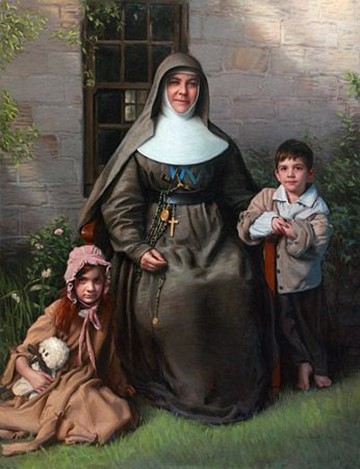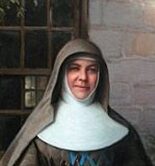The tiny face of the boy in the rowing boat was screwed up in fear.
Every time Mary MacKillop visited the orphanage at Kincumber on the Central Coast of NSW, three boys were sent to Woy Woy to transport her the five kilometres across Brisbane Waters. Two boys rowed, and the other one had to furiously bail water out of the leaky boat with a bucket.
On this occasion, one of the boys had a beaten, hang-dog look. ‘Please, Mother,’ he confessed, ‘Sister sent me to tell you I stole a loaf of bread.’

If this boy had lived a hundred years earlier in England, he would have been dragged into court to face a magistrate. His punishment would probably have been a sentence of transportation to the other side of the world to spend seven years in Australia as a convict. And even now, in nineteenth-century Australia, children were not protected by law. This would not happen until about the time Mary MacKillop died in 1909. So this boy had a very real reason to be frightened.
But Mary MacKillop – also known as Mary of the Cross – had been a caring nun for many years, and she knew that justice needed to be tempered with mercy. She could see that this orphan was not a criminal, but a victim of a society unable to look after its most vulnerable people: orphaned children.
Mary MacKillop’s own early childhood had not been easy. Her parents were Scottish immigrants who settled in Melbourne, and Mary was born there on 15 January 1842. Her family struggled at times, as the uncertainty of the ‘boom and bust’ gold rush days meant that the MacKillops often didn’t have enough money.
However, Mary also grew up going to church with her family, and expressed her caring nature from an early age. From her teens to her mid-twenties, Mary supported her family by working in a stationery business and then as a schoolteacher and a governess. Then, when Mary was 24 years old, her Christian faith, which underpinned everything she did, led her to take two very courageous steps: she opened a school, and she dedicated her life to serving God and others by becoming a nun.
Mary wanted to serve the poor, and particularly to educate children who lived in the bush. On 19 March 1866, she opened a school in a stable wearing a simple black dress as an outward sign of the huge life change she had chosen to make. This first school set the pattern for many other schools that would follow. It was for the children of the working class, providing a basic but thorough education with the aim of making children independent and employable.
Other young women joined Mary MacKillop and worked to establish places of refuge and rehabilitation for people in need, in addition to the schools. Together, these women came to be known as the Sisters of St Joseph, and they dedicated their lives and their work to meeting the physical and spiritual needs of struggling people.
Things didn’t always go smoothly for Mary in her work. One of her most difficult experiences was when the Catholic Church excommunicated her (cut her off from the Church) for a short period of time in late 1871 and early 1872. This action was soon understood as unfair, and she was welcomed back.
Most people would become angry and bitter if they were treated unfairly like this, and might try to find ways to retaliate; but Mary refused to behave in such a negative way. She came through the experience displaying love and compassion to all: a Christlike quality that characterised her life.
Mary’s understanding of human nature endeared her to many people. A novice nun was once sent to her for discipline after losing several heavy bags of soup bones on her way back from town. But Mary listened patiently to the nun’s account of how this happened: ‘So many dogs were following me that I felt sure that you would rather the dogs eat the bones than that they would eat me!’ No punishment was given.
In a stiff, strict world where excuses were rarely tolerated, Mary MacKillop’s kindness and understanding were remarkable. One example that shows the long-lasting impact of her kindness is the story of how, after Mary’s death, another nun saw a picture of her in a shop and asked to buy it. The shopkeeper refused to sell it, saying that Mary had saved him and his wife from starvation. Although he was not a Catholic, he had always helped the orphanages that Mary had founded.
Mary of the Cross was canonised (officially declared to be a ‘saint’) by the Catholic Church in 2010. She had, however, already been honoured and well-regarded by many Australians for well over a century. Her fame comes from her founding role in the Sisters of Saint Joseph: a Catholic order of women who devote themselves wholly to the service of God by serving the poor of the world. This movement has now spread well beyond Australia and has operated in New Zealand, Ireland, Peru, East Timor, Scotland and Brazil.
Many people start organisations that continue to exist beyond their own lifetimes. Some climb to the top through clever and ruthless tactics, stepping on others to gain wealth or fame; but others attract help and volunteers because of their selflessness. Mary MacKillop’s attitude was always one of forgiveness and respect. Her many letters provide evidence of her vision, courage, leadership, and the Christian faith that motivated her life’s passions and actions.
The Sisters of St Joseph, started by Mary MacKillop over 140 years ago, continue to this day.
Written by Annie Hamilton.
References and further reading:
Conversations with the Sisters of Saint Joseph at the Mary MacKillop Centre in East Melbourne
L O’Brien, Mary MacKillop Unveiled, John Garratt Publishing, Mulgrave, Victoria, 2008.
Sister of St Joseph, Memories of Mary by Those who Knew Her: 1925–1926, John Garratt Publishing, Mulgrave, Victoria, 2010.

